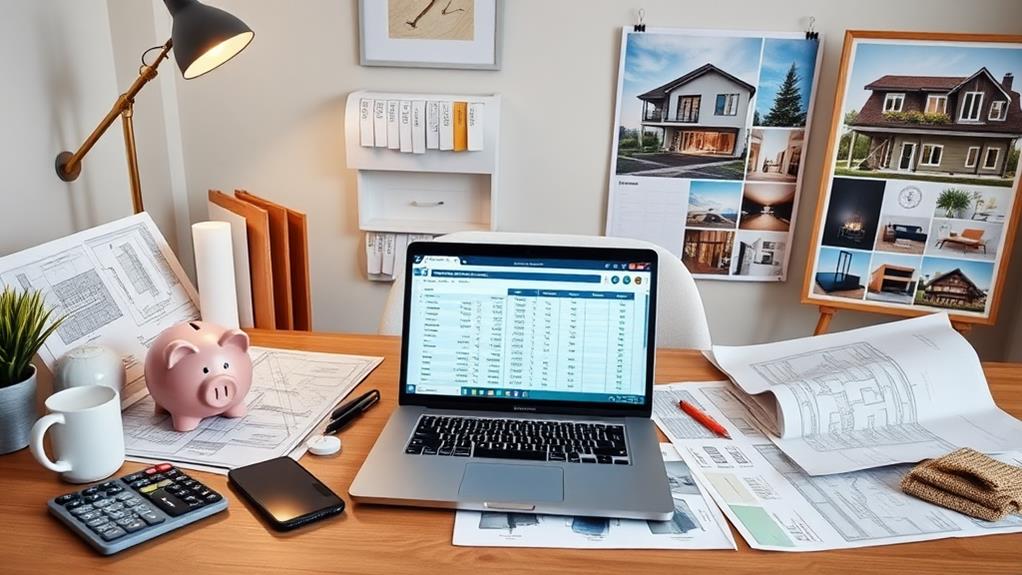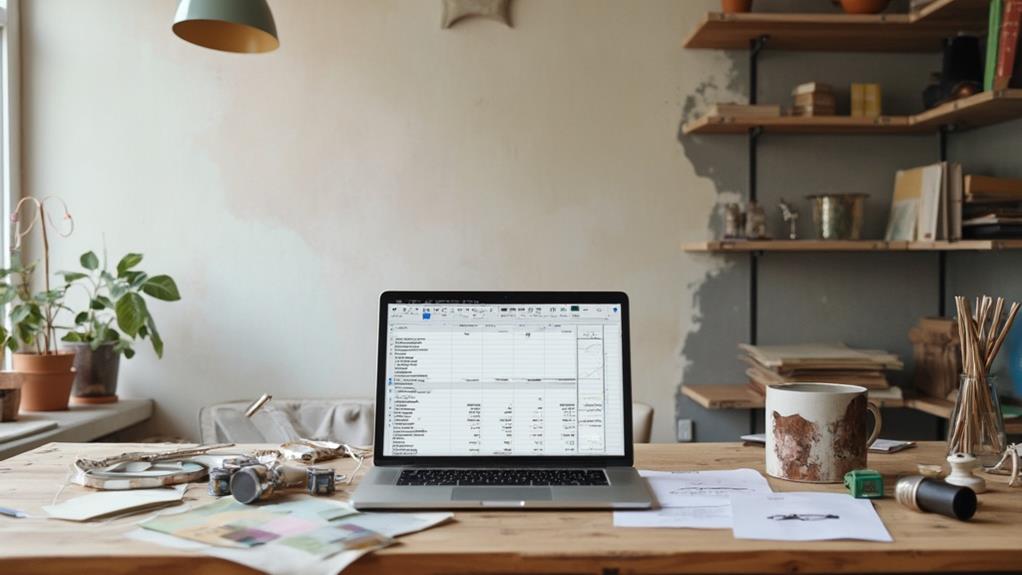Balancing aesthetic desires with budget constraints during home renovations requires strategic financial planning and meticulous expense tracking. Start by setting clear financial goals and creating detailed budget spreadsheets. Utilize expense tracking apps to monitor real-time costs and categorize spending. Implement category-based spending limits to prioritize essential improvements while controlling costs for less critical aspects. Conduct regular financial check-ins to review expenses, analyze discrepancies, and adjust plans as needed. This approach helps maintain financial discipline while still achieving desired aesthetic outcomes. By following these steps, you'll be better equipped to navigate the challenges of home renovation budgeting and realize your vision within practical constraints.
Set Clear Financial Goals

Before embarking on any home renovation project, setting clear financial goals is crucial. This initial step provides a solid foundation for balancing aesthetic desires with budget constraints.
Start by determining the total amount you're willing to invest in the renovation, considering both savings and potential financing options. Break down this overall budget into specific allocations for different aspects of the project, such as materials, labor, and unforeseen expenses.
Prioritize your renovation goals, distinguishing between essential improvements and desirable upgrades. This prioritization helps in making informed decisions when faced with budget limitations. Research current market prices for materials and services to ensure your financial goals are realistic and achievable.
Consider creating a contingency fund, typically 10-20% of the total budget, to account for unexpected costs or changes in project scope. Set milestones for your financial goals, aligning them with different phases of the renovation. This approach allows for better tracking of expenses and helps prevent overspending.
Create Detailed Budget Spreadsheets
Creating detailed budget spreadsheets is a critical step in managing your home renovation project effectively. These spreadsheets serve as comprehensive financial roadmaps, allowing you to track expenses, allocate funds, and maintain control over your renovation costs. Start by listing all anticipated expenses, categorizing them into major areas such as materials, labor, permits, and contingencies. Include columns for estimated costs, actual costs, and variances to easily identify discrepancies.
Utilize digital tools like Microsoft Excel or Google Sheets to create dynamic spreadsheets that automatically calculate totals and percentages. Include formulas to track overall budget consumption and remaining funds. Break down larger expenses into subcategories for more precise tracking. For example, under "materials," list specific items like flooring, paint, and fixtures separately. Regularly update your spreadsheet with actual costs as purchases are made and work progresses. This real-time tracking helps you stay on top of your budget and make informed decisions about potential changes or cost-saving measures.
Additionally, consider including a timeline column to align expenses with project milestones, ensuring proper cash flow management throughout the renovation process.
Utilize Expense Tracking Apps

One effective way to complement traditional budget spreadsheets is by leveraging expense tracking apps specifically designed for home renovation projects. These digital tools offer real-time updates and categorization of expenses, allowing homeowners to monitor their spending with greater accuracy and convenience.
Popular apps like HomeZada, Homebook, and Renovate provide features tailored to renovation projects, including material cost tracking, contractor payment schedules, and budget allocation across different rooms or project phases. Users can easily input expenses on-the-go, attach receipts, and generate reports to compare actual costs against initial estimates.
Many of these apps also integrate with financial institutions, automatically importing transactions related to the renovation. This seamless synchronization reduces manual data entry and minimizes the risk of overlooking expenses. Additionally, some apps offer collaborative features, enabling multiple users to update and view the budget simultaneously, which is particularly useful when working with contractors or sharing responsibilities with family members.
Implement Category-Based Spending Limits
To effectively manage a renovation budget, implementing category-based spending limits is crucial. This approach involves dividing your total budget into specific categories, such as flooring, lighting, plumbing, and furniture, and allocating a maximum spending amount for each. By setting these limits, you create a clear financial framework that helps prevent overspending in any particular area.
Start by prioritizing renovation elements based on importance and impact. Allocate larger portions of your budget to high-priority items and essential structural work. For less critical aspects, set stricter spending limits to ensure you stay within your overall budget. Regularly review and adjust these category-based limits as your project progresses, allowing for flexibility when unexpected costs arise.
This method also facilitates better decision-making when selecting materials and finishes. With a predefined limit for each category, you can quickly assess whether a particular item fits within your budget constraints. If you find yourself exceeding a category limit, it prompts you to either seek more cost-effective alternatives or reassess your priorities. Ultimately, category-based spending limits provide a structured approach to balancing your aesthetic desires with practical budget constraints throughout the renovation process.
Regular Financial Check-Ins

While category-based spending limits provide a solid foundation for budget management, regular financial check-ins are necessary to maintain control throughout the renovation process. These check-ins should be scheduled at consistent intervals, such as weekly or bi-weekly, to assess the project's financial status and identify any potential issues early on.
During these check-ins, review all expenses incurred since the last meeting, comparing them against the established budget categories. Analyze any discrepancies or unexpected costs, and adjust future spending plans accordingly. It's crucial to involve all key stakeholders, including contractors and designers, to ensure transparency and accountability.
Use these sessions to forecast upcoming expenses and reassess project priorities if necessary. If certain areas are approaching or exceeding their allocated budgets, consider reallocating funds from less critical aspects of the renovation. Additionally, track the overall project timeline and how it correlates with spending to avoid unexpected financial strain due to delays or changes in scope.
Frequently Asked Questions
How Do I Handle Unexpected Expenses During a Home Renovation?
To handle unexpected expenses during a home renovation, maintain a contingency fund of 10-20% of your budget. Prioritize essential repairs, negotiate with contractors, and consider adjusting your project scope or timeline if necessary. Stay flexible and communicate openly with your team.
Should I Prioritize Quality Materials or Labor Costs in My Budget?
In the heart-stopping realm of home renovation, prioritizing quality materials over labor costs is generally wise. High-quality materials ensure longevity and better aesthetics, while skilled labor can be found at competitive rates through thorough research and multiple quotes.
What Percentage of My Budget Should Be Allocated for Contingencies?
For home renovations, it's generally recommended to allocate 10-20% of your total budget for contingencies. This buffer helps cover unexpected costs, such as hidden structural issues or last-minute changes, ensuring your project stays on track financially.
How Can I Negotiate Better Prices With Contractors and Suppliers?
Research, compare, and communicate clearly to negotiate better prices. Get multiple quotes, bundle services, and leverage off-peak seasons. Be transparent about your budget, offer flexible payment terms, and consider bulk purchases to secure discounts from suppliers.
Are There Tax Deductions Available for Home Renovation Expenses?
Some home renovation expenses may be tax-deductible, particularly for energy-efficient upgrades or home office improvements. However, most general renovations are not deductible. Consult a tax professional for specific advice regarding your situation and applicable tax laws.
Conclusion
Effective expense tracking is crucial for successful home renovations, balancing aesthetic desires with practical budget constraints. By setting clear financial goals, utilizing detailed spreadsheets and apps, implementing category-based spending limits, and conducting regular check-ins, homeowners can maintain control over their renovation costs. Interestingly, according to a 2021 Houzz study, 46% of homeowners went over budget during renovations. This statistic underscores the importance of diligent expense tracking to avoid financial pitfalls and ensure project completion within desired parameters.

